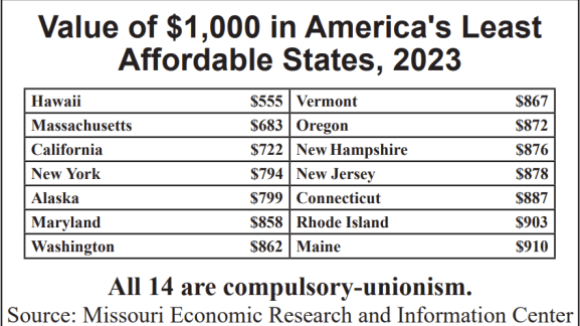Banning Compulsory Dues Curbs Cost of Living
On average, forced-unionism states are 23.2% more expensive to live in than Right to Work states. And decades of academic research show that compulsory unionism actually fosters a higher cost of living.
 A tale of two cities
A tale of two citiesRight to Work Kansas City, KS continues to provide an excellent example of why Missouri should become the 25th Right to Work state. From the National Institute for Labor Relations Research’s Stan Greer:
The two largest Kansas City metro area counties on the Missouri side of the border, Jackson and Clay, endured respective private-sector employment declines of 8.2% and 1.1% from 2002 to 2012. Jackson and Clay counties lost a combined total of more than 36,000 jobs.
Meanwhile, the two largest Kansas City metro areas located in Right to Work Kansas, Johnson and Wynadotte, respectively chalked up private-sector job gains of 7.6% and 13.8%.
Writing for National Review Online late last summer, economic analyst Kevin Williamson pointed to data showing that the Right to Work portions of the Kansas City metro area have long been, and are continuing to, in his words, “eat[ ] the economic lunch” of the forced-unionism portions:
Kansas City saw about 9,500 new jobs created between May 2012 and May 2013 – every one of them on the Kansas side of the border, where residents and businesses enjoy a significant tax advantage . . . . Johnson, County, Kan., gained nearly $800 million in adjusted gross income between 1992 and 2010 [due to net domestic in-migration], and the biggest chunk of it came from Jackson County, Mo., which is down some $1.78 billion in AGI over the same period.[3]

On average, forced-unionism states are 23.2% more expensive to live in than Right to Work states. And decades of academic research show that compulsory unionism actually fosters a higher cost of living.

Jewish MIT students assert their rights under Civil Rights Act by requesting religious exemptions from funding union, but union officials continue to demand dues payments

Thanks to the Committee's election-year program, union-label candidates like Sen. Jon Tester (Mont.) are being given a choice: pledge to change course and support Right to Work going forward, or face the potential political consequences.